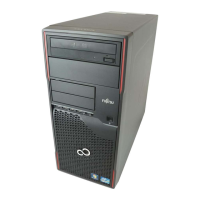Getting s tarted
Connecting external devices to the parallel
(optional) or serial port
ParallelportSerialportParallelportSerialp ortExternaldevicesDevices
External devices can be connected to the pa rallel or serial port (e.g. a printer or a modem).
► Connect the data cable to the external device.
► D epending on the device, conn
ect the data cable to the parallel p o rt or the serial port.
For an exact description o
f how to connect external devices to the corresponding
port, please refer to the d
ocumentation of the external device.
Port settings
ParallelportSerialport,
You can change the port settings (e.g. add ress, interrupt) in the BIOS Setup.
Device drivers
Deviced riversDevice drivers,
The device s connected to t he parallel or serial port require drivers. Your operating
system already includes many drive rs. If the required drive is missing, install it. Current
drivers are u sually available on the Internet or will be supp lied on a data carrier.
Connecting external devices to the USB ports
USBdevices,USBport,Externaldevices,Devices,
You can connect a wide range of external devices to the U SB ports (e.g.
printer, scanner, modem or keyboard).
USB devices are hot-pluggable. This means you can connect and disconnect
USB cables while your device is switche d on.
Additional information can be found in t he documentation for the USB devices.
► Connect the data cable to the external device.
► C onnect the data cable to one of the USB ports on your device.
Device drivers
The external USB devices you conn ect to the U SB po rts usua lly require no
driver of their own, as the re quired softw are is alrea dy included in the operating
system. Howe ver, if the external USB device requires its own software, please
install it from the data carrier provided with the USB device.
To ensure the transmission capacity of USB 2.0, the cable from the external USB
device to the USB port of your device must not be longer than 3 m .
18 Fujitsu Technology Solutions

